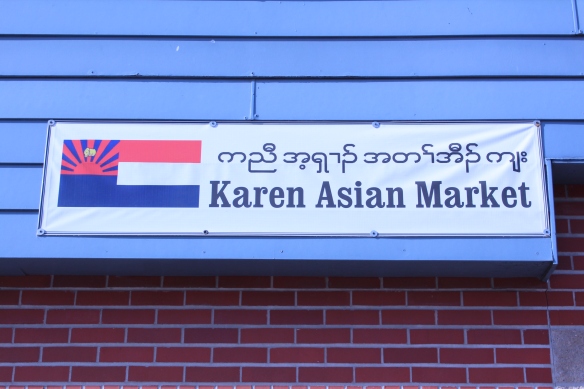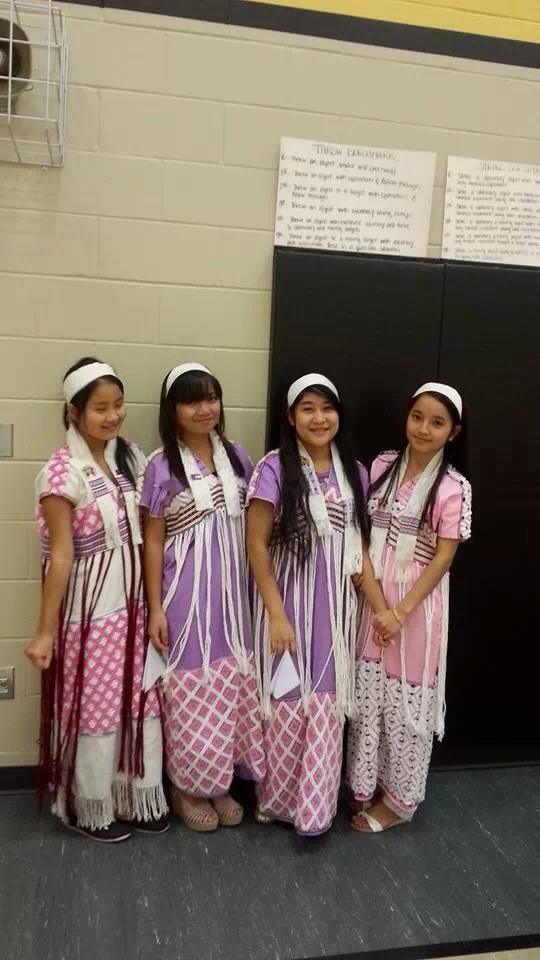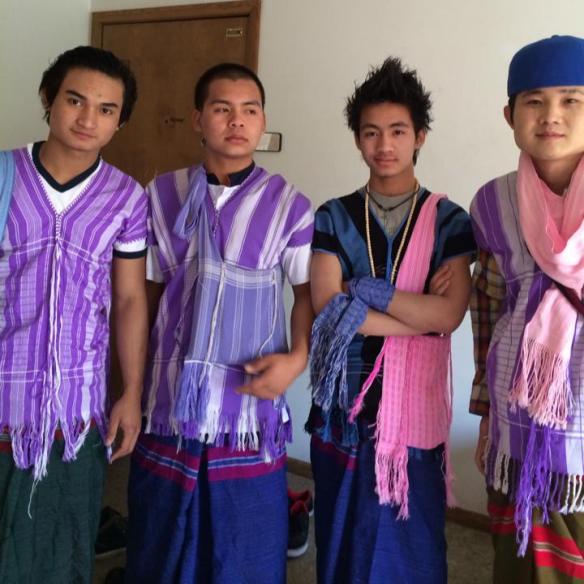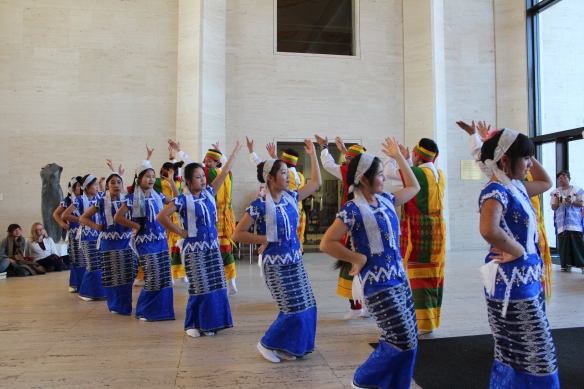Author Archives: digitalstorytelling15
April Paw, pt. 1
 My name is Der Htoo and I was born in a refugee camp called Mae la located in the Tak province and Tha Song Yang district of northern Thailand on April 11, 1998. For some unknown reasons when I was born, I was awfully dark for an Asian baby, which was taboo. Some of the most memorable moments of my life come from growing up in the camp, even though I was really young at the time. I recall being the most handsome looking kid a mother and father could’ve ever raised or made. Well, that’s what I thought.
My name is Der Htoo and I was born in a refugee camp called Mae la located in the Tak province and Tha Song Yang district of northern Thailand on April 11, 1998. For some unknown reasons when I was born, I was awfully dark for an Asian baby, which was taboo. Some of the most memorable moments of my life come from growing up in the camp, even though I was really young at the time. I recall being the most handsome looking kid a mother and father could’ve ever raised or made. Well, that’s what I thought.
Growing up in the camp, mom and pop couldn’t afford a lot for us. They rarely made money since my pop was the chief of our zone, which often caused him to be super busy at most times, and mom had 6 children on her hands to look after. If they ever did make money, it went towards our family’s daily stomach fills. My grandma was the actual breadwinner of the family. Already at her prime, she worked non-stop at a hospital, where the money she made, was money she gave to us for church offerings and sometimes to buy ourselves some snacks here and there.
I spent most of my time in the camp playing, like every other kid. However, my way of killing time was a bit out of the ordinary for a kid. I had a thing for making gun powder. I learned the formula from a local hunter near by our hut; with a little potassium nitrate, a bit of sulfur and a whole lot of luck, I ended up burning one of my eyebrows off and blowing up half of my neighbors bathroom. Even afterward, I stole their jug of water to dip my whole head in for the rest of the day. Speaking of stealing, I was the number one thief in the town. I would steal stuff I couldn’t afford or stuff I didn’t already have such as shoes, watches, shirts from people swimming in the river, local Thai soldiers’ vegetables plants that caused me to get some good chasing by the soldiers and a lot more including getting shot at once. I got so good at stealing, I stole one of my dad’s friend’s money while he slept and I stole some eggs from the parents of my ex girlfriend while they were watching me. You’re probably wondering how’s that possible, well I have no idea. They probably just thought to themselves while watching me…”This kid believes he’s so slick, we’ll just let him be.”
Days became weeks, weeks became months, months became years and years flew by as if they had wings, and the time to move to the U.S. had finally come. Honestly none of us wanted to come, but we needed the resources and opportunities that weren’t available for us in the camp such as education and Wi-Fi. Also the Thai government, during that time, threatened to send us refugees back to Burma and let us get shot to death while crossing the river that was well over our head. I think any sane person would say, “hell no” to that. So we packed up the little bit of belongings that we had and boarded a giant bus with tears on our face on the last day which was July 3, 2007. We got on the first plane at Suvarnabhumi Airport. Everything was awful. The airplane ride was awful, the food was extremely awful, and the bathroom was super extremely awful, because I accidentally locked myself in the bathroom and spent most of the ride sitting on the toilet waiting for someone to save me before the landing.
Finally, we made our first stop at Incheon international Airport in Seoul, South Korea and ohh my gosh those lady servants on the planes were so cute, I thought they’d all make good housewives.They were also very kind. I remembered us having to wait almost a whole day in Incheon airport because of some unknown reasons. Anyways, so we waited and waited, jet lagged and all, it felt like forever. Some Korean lady working there happened to sympathize with us skinny refugees and brought us some sandwiches. It’s hard to not notice a group of skinny people walking around with big colorful striped bags looking like one of those starving children in the commercials you always see on T.V, but most people could care less. I had lost my appetite at the time, we all did, but I was touched by her actions.
Post written by April Paw
Moo Ku Taw
 My name is Moo Ku Taw. I was born in Thailand. When I was 2 months old, due to war, my family fled to a refugee camp in Thailand. I lived in a camp called Umphiem. The UN provided us with a little food every month, like rice, oil, and beans, but many people did not have enough food. I was raised in Umpiem and spent most of my life there until 2008 when I came to the United States.
My name is Moo Ku Taw. I was born in Thailand. When I was 2 months old, due to war, my family fled to a refugee camp in Thailand. I lived in a camp called Umphiem. The UN provided us with a little food every month, like rice, oil, and beans, but many people did not have enough food. I was raised in Umpiem and spent most of my life there until 2008 when I came to the United States.
Life in Umpiem was not as simple as it is here. The house I lived in was a stilt house made out of bamboo, with a roof made out of hay. We did not have running water, electricity, or transportation. To get water, we had to walk miles to the river. There, we would fill our big water bottles and bring them home to fill the water barrel. We had to do that several times until our water barrel was full. Our house had many windows to get as much light as we could to study during the daytime. At night, we used candles, but they didn’t shine through the whole house.
To get an education, many people had to walk 30-40 minutes every day. Some people didn’t get to go to school because their family could not afford it and some had to support their family. I was lucky because I had the chance to go to school and learn. I went to school there for four years until I came to America. We had to wear uniforms every other day and a Karen shirt on the other days. Some people could not buy new uniforms, so they had to wash it as soon as possible to get it clean.
We had to study and do our homework every single night. If you did not do it, the teacher would hit you or make you run around school as everyone watched you. Our school was poor. Our walls were made of bamboo and metal roofing. We had a small chalkboard in every class. Usually, there were six rows of long benches and tables that were made out of bamboo for us to sit. Boys sat on one side and girls on the other side. We did not have computers or light. Our roof had holes, but it wasn’t replaced because it was too expensive, so when there were storms, rain water leaked on us. Many times we had to run home because it had rained and there weren’t meteorologists there to tell us about the weather. Many people got soaked and became sick.
Coming to America, life was so much easier. School is better and life got better. We do not have to walk far to get water because we have running water. We have transportation here and it makes life much easier. My goal for this project is to share about the Karen life in a Thai refugee camp.
Written by Moo Ku Taw
EhSerNayBlutMoo
 My name is EhSerNayBlutMoo but I shortened my name to EhSer. Most people called me Aye Li Yah. I am from Thailand, and lived in the Umphiem Refugee Camp. I moved to the United States when I was 9 years old and entered the fifth grade at Holmes Elementary in Lincoln, Ne. Things were difficult for me because I didn’t understand any English. By the time I understood English I was in middle school at Park Middle. Many teachers supported me over there because they wanted me to be a good student. Now, I am a freshman at Lincoln High School. Things are sometimes difficult for me, but I study hard anyways. To be successful in the future I have to work hard on my school work. In the future, I hope to attend college.
My name is EhSerNayBlutMoo but I shortened my name to EhSer. Most people called me Aye Li Yah. I am from Thailand, and lived in the Umphiem Refugee Camp. I moved to the United States when I was 9 years old and entered the fifth grade at Holmes Elementary in Lincoln, Ne. Things were difficult for me because I didn’t understand any English. By the time I understood English I was in middle school at Park Middle. Many teachers supported me over there because they wanted me to be a good student. Now, I am a freshman at Lincoln High School. Things are sometimes difficult for me, but I study hard anyways. To be successful in the future I have to work hard on my school work. In the future, I hope to attend college.
Post Written by EhSerNayBlutMoo
Snow Paw
My name is Tin Htay. Most people call me Snow Paw. I’m from the Mae La Camp in Thailand. My family and I came to the USA to flee the war and find better jobs and more opportunity with our education. We faced many struggles when we came to the United States. The language, food, and places are different, so we had hard time. As my life goes on I felt discouraged. People would laugh at us because we eat with our hands and we are different from them. They didn’t know about Karen people and the struggles our people have undergone because of wars, poor food, clothing, and not good education for us.
Later on I was able to learn that more Karen people came to live in the USA and our title of “Karen” have been spread around. Having an opportunity to come to the USA is a great help to our Karen People. I’m very thankful to have learned education, to help out my family after all they been through to get us to a better place. I will never forget my parents courage to bring us to USA. I can feel all their hardship, their depression, and the opportunity they never had in life. My goals are to bring happiness to our family. I want to study hard to go to college and become a teacher. I want my parents to rest from their hardship because of their children. I want to see them smile. I want them to take the credit for bringing us here. Life in US is the best life I have ever had. I can study hard to fill my dream. A lot of people have helped me when I needed them. They bring me up when my world is upside down. This world is what people call Earth. Earth is where everything is peaceful and full of Love. I want to live in a world that have understanding, peace, love, and friends who will bring you up when you are down.
Post Written by Snow Paw
Karen Food
The students involved in the Tah Ka Pal project have been documenting Karen food for several months. Food is very important part of all the cultures. You will know more about Karen community if you know our food. Many Karen people buy food at Karen Market and Asian City Mart. Both of these markets are owned by women from Myanmar. The food sold at these markets are similar and are from Myanmar and Thailand. We interviewed the owners about their experience.
Most Karen people like to eat fresh vegetable and some meat. They like to eat spicy food rather than any other food. Unlike Americans, Karen people eat the same kind of meal in the morning, noon, and in the evening. The most famous food is Tah Ka Pah. It has a meaning to it. Long ago Karen people were in hunger and didn’t had enough food to eat. So they made Tah Ka Pah with vegetable, rice, bamboo shoot, pepper, and some meat. They mix together to get more food so they can share with everybody. People can buy these ingredients at the Karen market and the Asian City Mart.

Ta Kwie Duh is part of a banana tree. Karen People use this to make a noodle soup, and any others thing.
Nang May is not Karen. She is Shan which is an ethnicity from Myanmar. Nang May also sells food that Karen people buy. She was happy to have her own market because she got to see people everyday so she won’t be alone. She choose to live in U.S because Nang May wants her daughter to have a higher education. She said her daughter can study better than in Myanmar.
Right now we are working on video about Karen food. This video includes Nang May, and Hgee Lah doh. We want people know about their experience and how hard they work. Refugee people can still cook with these familiar food because of these stores.
Post written by Paw Spai Moo, and Macho Pi
Karen Traditional Clothing
Every culture has their own traditional clothing. Karen people also has their own traditional clothing. Before we turn fabric into clothing, we use cotton to make it into thread. Then we use thread to weave our clothes. Karen traditional clothing is very special for the Karen New Years and everyone have to wear it.

Tin Htay is wearing the clothing she dances in with the Karen dance group in Lincoln. Young dancers will wear brighter colors and older dancers will wear more of black, orange, and green.

Mue Gay Wah is wearing clothing of married woman. This clothes show that whoever wear it is married already.
Karen clothing has meaning. Not all Karen people wear the same clothing, they have identity with age. When they are young and have not already married, they used to wear a long dress. Once they marry they have to wear short shirt with skirt that is wrapped around at their waist. In their own culture if they didn’t obey this tradition, a tiger will come eat them or take them away. Most of the people in Karen village, they knew how to make Karen traditional clothing. Even kids learn how to do it.
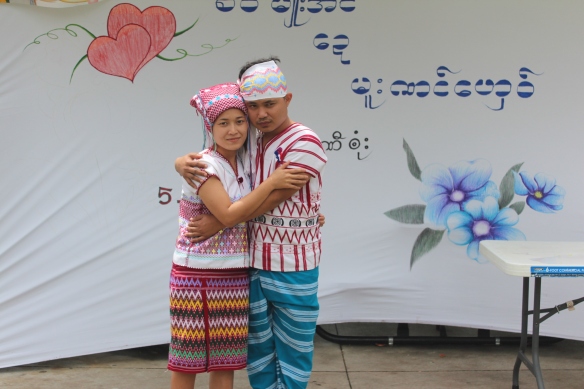
Mue Naw Gay and Myo Aung celebrated their marriage. Married woman wear short shirt and short skirt that tied around waist.
Right now it’s different from the past. Now people use those weavings to make it into pants and different designs of clothing. Most people forget about their own traditional clothing. The Karen traditional clothing now is not that traditional anymore since some people use it in the wrong way and wear it in an inappropriate way. Now, the Karen people are not loyal to their ancestors by not wearing Karen clothing. Some people do what they want because they have forgotten their tradition and the teaching of their ancestors. Since some people were separated from Burma, they haven’t wear their traditional clothing often. They wear more simple clothes like other cultures do.
Post written by Paw Spai Moo and Tin Htay.
Quilted Conscience
Many people came to see the finished quilt piece on the Sunday of March 23rd. A group of students from Lincoln High worked on the quilted conscience project in the beginning of school year. There are about 16 students who were involved in the project who are from Burma and Thailand. We had been working on this project for one week in September, 2013. We did this to represent our dreams and memories. The first day we had to draw a picture and describe what’s the meaning of the picture. All of the students were very delighted to share about their memories and dreams. When we did this project, some of Quilters participate to help us how to sew the fabric. They were so kind and very helpful. The quilt included the weaving that the Karen parents did along with the piece that the student did. The quilt will be on display in the museum. On the final day everyone was invited to see the finished piece. Many people came to the event to see it. During the final day there were Karen traditional dancing and singing. The students introduced themselves and shared a few things about their piece. At the celebration some Karen students performed a Karen traditional dance called, “Don Karen Dance.”
When the quilt is finally displayed people will see the visual arts that the students had made from their memories and goals. When you look at the quilt it is as if you are reading many chapters of one book.
–Written by Paw Spai Moo and Paw Say.
Wah Poe
Aside
My name is Wah and I was born in Thailand and thanks to my parents, I didn’t have to live in Myanmar where people were killed. Some Karen people had been running from Myanmar’s soldiers through their whole lives. My parents moved to Thailand hoping to start a new life and that is where I was born. When I was 8 years old, they decided to go live with my grandma in a Karen refugee camp, with the money they had. My parents were going to rebuild her house and live together as a big family.
Before my family moved to live with my grandma, I went to Thai school for four years. After we moved, I went to Karen school in the refugee camp. In the Karen refugee camp there were no restrooms or things to eat in the afternoon. There are a lot of different things that Karen school doesn’t have like Thai school did. The school’s walls were made out of bamboo and the building was old. Each class is different, some don’t have floors so some students sit on the ground.It get worst when is raining season, water came down from ceiling like water fall. I wish someone would fix school up.
Even though I am Karen in blood, I didn’t know how to speak, read, or write in Karen. It is hard to learn your own language at first but it gets easier as I stay there. In school the teacher taught more than one language like Burmese and Karen. The words are almost the same but sound different. I learned more than three language at once but It was too hard for me so I just focused on Karen language. At home my parent only speak in Karen so I understand little of what they said. Sometimes if they didn’t want me to know what they said then they speak in Burmese which makes me curious.
In school I sometimes have hard time learning things so the teacher sometimes uses physical force to teach and it works. I got used to it quick and learned what happens if I didn’t get it in my head the first time. Sometimes I fear school so much that I cry at night worrying about undone work.
I lived in the Karen camp for 3 years and then moved to the US. But, moving from place to place, I have to learn to adapt to new cultures, people and languages.
My goal for this project is to share what is like being in Karen school.
Post Written by Wah Poe
Khu Htoo
My name is Khu Htoo and I was born in a Karen refugee camp in Myanmar. Before I came to United States, I lived with my family for more than 12 years in the refugee camp. My family and my people had to escape Myanmar during the war because we would be killed if the Burmese soldiers saw us. The war is known as the invisible war because it is going on in Myanmar and not a lot of people or nations know about it. A lot of Karen villages were burned down, so we had to live in refugee camps in Thailand.
When I came to United States, I felt discouraged because people don’t know about the Karen people. They didn’t know where we came from and why we came to the United States. As more and more Karen people moved to the United States as refugees, we become a minority group but we are not recognized yet.
It was memorable during the first month of our arrival in Lincoln. I remember my first day at Park Middle School because it didn’t go well. I felt invisible, like a ghost, because when I talked, people didn’t understand what I was saying. It was like I was from another world and went to the unknown world. When I arrived, I didn’t know which entrance to take, so I just followed people inside the school. When I got into the school I was so confused because I didn’t know what to do and didn’t know how to ask for help. So, I just stood by the locker room until one of the teacher came up to me and assisted me. Later, that teacher became one of my favorite teachers and she had a powerful impact in my life.
We, the Karen students, wanted to create this blog to share with others about who we are. What does our culture look like? What are our stories? Lastly, how do Karen people live and work in Lincoln?






